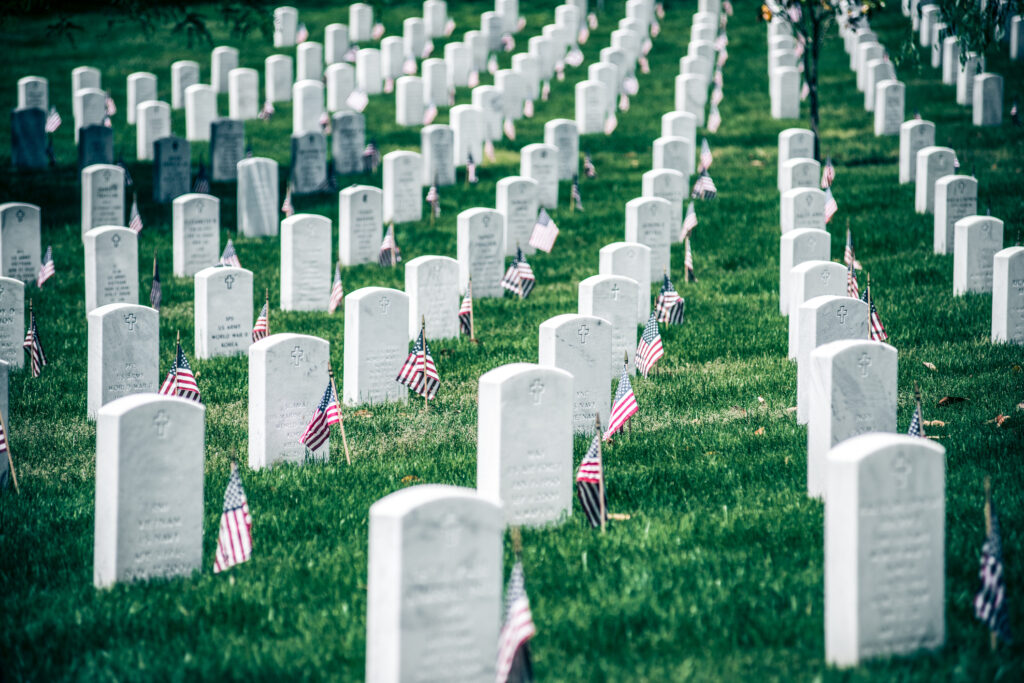For a holiday that’s all about remembering, the real meaning of Memorial Day is often forgotten.
Ask anyone in America what Memorial Day is all about — and how they celebrate it — and you’re likely to hear about the start of summer. True, its celebration on the last Monday in May is often a key calendar marker. Pools open, fashions change (safe to wear white, all the way up to Labor Day!), and the school year is wrapping up. You’ll also hear people mention Memorial Day sales, and while some items are clearly necessitated by the demands/opportunities of a new season — outdoor furniture and home improvement tools — appliances and mattresses apparently get honorable mentions, too.
A 2021 poll showed that the most popular Memorial Day weekened activity was “stay home and relax” (32%). Getting together with family (22%) and having a cook-out (21%) rounded out the top three, with a distant 9% planning to visit gravesites and 5% attending Memorial Day events. Even household chores (16%), doing nothing at all (16%), and yard work (14%) beat out activities related to this holiday’s true purpose.

History of Memorial Day
Memorial Day honors those who died in US military service, and multiple towns and groups claim to have originated this holiday in the late 1860s, in the aftermath of the Civil War. With so many fallen in both the north and the south, the country’s first national cemeteries were established, and many soldiers were buried far from home. Some credit southern communities with the first efforts to decorate the graves of all fallen soldiers, from both sides. Some highlight an event conducted by formerly enslaved people in Charleston, South Carolina.
Eventually called Decoration Day, one of the first “official” celebrations was proclaimed by General John Logan, to be commemorated May 30, 1868, “for the purpose of strewing with flowers, or otherwise decorating the graves of comrades who died in defense of their country during the late rebellionband whose bodies now lie in almost every city, village and hamlet churchyard in the land.” His wife wrote in her memoir that she suggested this holiday to him after seeing graves strewn with flowers in Virginia. The date itself was chosen because it wasn’t the anniversary of any particular battle.
On the first Decoration Day, General James Garfield gave a speech at Arlington National Cemetery. Following the speech, 5,000 participants decorated the graves of the more than 20,000 Civil War soldiers buried there. Many states began to follow the tradition, some on different dates. In 1966, President Lyndon Johnson officially recognized Memorial Day, and cited its origin as a community event held in Waterloo, New York. Waterloo is now home to the National Memorial Day Museum.
While Decoration Day began to honor those lost in the Civil War, the nation’s involvement in World War I and subsequent conflicts led to an expanded range of recognition. Memorial Day was celebrated on May 30 for many years, until Congress passed the Uniform Monday Holiday Act, which both established Memorial Day as the last Monday in May and designated it a federal holiday.
Memorial Day in calendar context
Interestingly, many Americans aren’t entirely clear on the difference between Memorial Day and Veterans Day. A recent study showed that less than half of those surveyed correctly described the purpose of Memorial Day and 36% weren’t sure how the two holidays differed.
Veterans Day honors those who have served in the US military. Originally celebrated as Armistice Day, due to the armistice signed ending World War I on November 11, 1918, the holiday was expanded to honor Americans who have served in all conflicts. In 1954, President Dwight Eisenhower officially changed the name and expanded the holiday’s purpose. Today, veterans are honored with ceremonial tributes, parades, and lots of appreciations and goodies from communities and businesses.
The Fourth of July is probably the most patriotic of all American holidays. While remembrance is certainly a part of this holiday, it is more of a celebration than the somber tones of Memorial Day or Veterans Day. July 4, 1776, was the date on which colonists adopted the Declaration of Independence, announcing their intention to separate completely from Great Britain. This holiday is celebrated with fireworks, barbeques, and festive concerts.
Honoring memory
On Memorial Day, flags are flown at half-mast as a sign of respect.
Many communities hold Memorial Day parades that lead to military memorials or cemeteries. Bands play patriotic music, there may be 21-gun salutes, and you’re likely to hear Taps played, too.
At Arlington National Cemetery, graves are decorated, and a wreath is laid at the Tomb of the Unknown Soldier.
Gold Star families, those whose immediate family members have died while serving in conflict, are honored and recognized for their sacrifice.
For many, poppies are a symbol worn on this holiday, as well as on Veterans Day. The poppy is a sign of remembrance that refers to “In Flanders Field”, a poem by Canadian Lieutenant Colonel John McCrae, in which fallen soldiers lie in a field where poppies grow.
At 3:00 local pm, although many may not know it, Americans are asked to pause for a National Moment of Remembrance. This moment was designated by Congress in 2000.
And yes, lots of people have picnics and barbeques, travel to spend time with friends and family, and just hang out and relax. Summer is on its way, and as many will remind you — we are lucky to live in the land of the free, thanks to the sacrifices of the brave.














